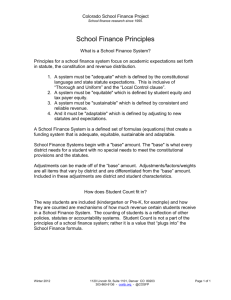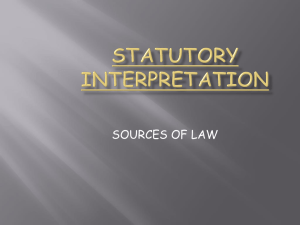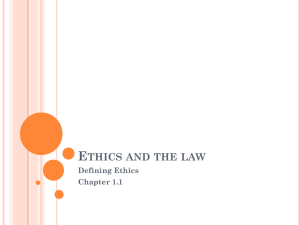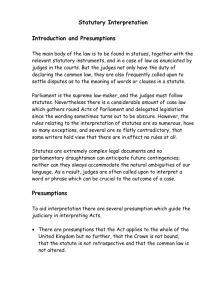English Legal System 3 PowerPoint
advertisement
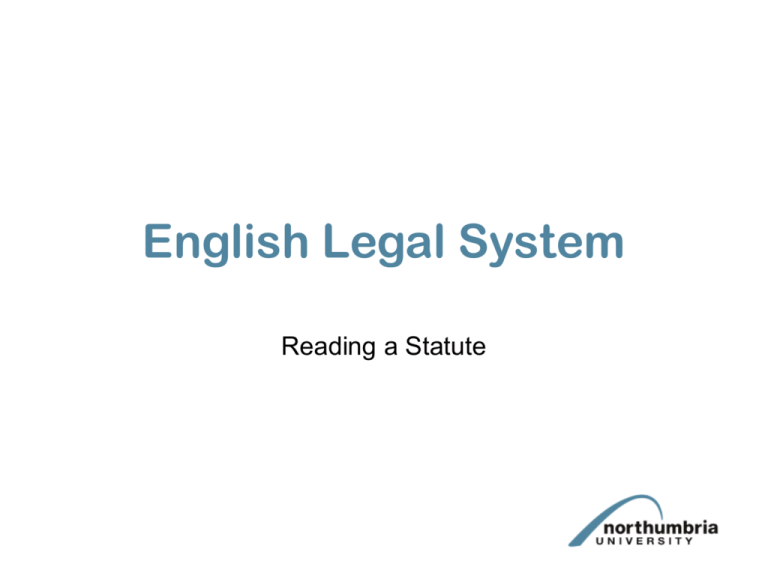
English Legal System Reading a Statute Aims • The aims of this session are: 1. To enhance and develop your knowledge of how a statute is structured; 2. To introduce you to the rules of statutory interpretation which the judges use; 3. To critically assess those rules in relation to specific examples; 4. To attempt to read a statute and answer some fundamental questions on it. Outcomes • By the end of this lecture you will able to: 1. 2. 3. 4. Locate a statute; Recognise the Long title; Recognise the short title; Identify sections and subsections of a statute and how to read them in conjunction with one another; Identify the interpretation section of the Act and how this applies Identify the importance of statutory guidance notes and State what the rules of statutory interpretation are and how they are applied by the courts in practice. 5. 6. 7. Sources of Law We looked in a previous lecture at sources of law In this lecture will be looking at legislation and in particular primary legislation and how it should be classified What is legislation? How can legislation be classified? • Primary and Secondary • Bills, Acts of Parliament, Statutes Scope of Acts of Parliament • Public Acts, Private Acts • Scope of Acts of Parliament, parliamentary sovereignty – no geographical limits on Parliament (although will not always) • Remember the English Legal System only includes England What is a statute? • We saw in the last lecture that a statute is a bill which has been approved by the Queen, Lords and Commons • In England and Wales it is, with the exception of European Law, the supreme legal source which takes precedence over any other law if there is a conflict • It is important, therefore, to be able to identify the different parts of a statute and how they come together and should be read How to find a statute? • Statutes are available in both printed and electronic form • The most authoritative series of statutes in the library is called Public General Acts • Halsbury’s also produce a series entitled the Statutes of England • Online statutes can be accessed through variety of different databases – the Butterworths Direct service provided by LexisNexis, and also the HMSO website, www.hmso.gov.uk • The latter only has Acts of the United Kingdom Parliament dating back to 1988 and these are listed by the date that the statute was passed so that you will need to know this before you can locate the correct statute • Butterworths on the computer provides a search engine Different styles of drafting a statute The drafting of statutes is affected by the aims and objectives that statute is trying to achieve. These can be characterised broadly as follows: 1) 2) A statute drafted in wide terms to allow discretion in the exercise of policy; A statute setting down a clear rule that must be followed. Statutory instruments are used to fill in the detail of the main provisions in an Act of Parliament There have been many criticisms made of how statutes are drafted – these will be covered when we look at the law-making process as part of the institutions of the English Legal System Citation of Statutes • Name and Year – now most common E.g. The Scotland Act 1998 • Year and chapter number E.g. The Unfair Contract Terms Act 1977, c.45 The Acts of Parliament in any year are divided into chapters and numbered according to the order in which they were passed that year • Regnal Year and chapter number Gaol Act 4 Geo 4 c 64 the 64th Statute of the 4th year of George IV’s reign Contents of a statute a) b) c) d) e) f) g) h) Short title, e.g. Official reference Long title Date of Royal Assent Preamble Enacting formula Sections, parts, schedules Extent Contents of a Statute continued i) j) k) l) Commencement Definition section Amendments Express repeals Exercise Find a copy of the Scotland Act 1998. Find the different sections of the Act listed above. The main body of the statute • Sections, subsections, paragraphs The main body of the Act is divided into sections, subsections and paragraphs It is important to pick up on the connecting words which are used to link these different provisions The provisions must be read as a whole refer than in part only Examples from the Scotland Act • The short title of this Act is obvious, it can be cited as the Scotland Act 1998 Not all titles are so straightforward or give a clear indication of what the subject matter of the statute is, e.g. The Unfair Contract Terms Act 1977 • Read the long title of the Act: ‘An Act to provide for the establishment of a Scottish Parliament and administration and other changes in the government of Scotland; to provide for the variation of the basic rate of income tax in relation to income of Scottish taxpayers in accordance with a resolution of the Scottish Parliament; to amend the law about parliamentary constituencies in Scotland and for related purposes’ Scotland Act exercise continued Questions: 1. What is the purpose of the long title? 2. How many objectives does it lay down for the Act to achieve? 3. Can you think of any difficulties presented in drafting the long title of an Act? Date of Assent and Commencement • The date at the top of the Act is the date of which the Act received Royal Assent, for further information in this process – see Parliament and law-making lecture • This can be the date of commencement • However, often there are commencement procedures in the Act itself Royal Assent and Commencement • In the Scotland Act, this can be found at s.130 and provides as follows: ‘130 (1) Sections 19 to 43, Parts II to V, sections 117 to 124 and section 125 (except so far as relating to paragraphs 10, 11, 19 and 23 (1) and (6) of schedule 8) shall come into force on such day as the Secretary of State may by order appoint (2) Different days may be appointed under this section for different purposes’ Questions and answers • What do you notice about the commencement procedures here? • Who do they give power to to bring in the legislation? • Why do you think that they come into force at times to be specified rather than at the time of the Royal Assent? • Research question: try to find by what mechanism the Secretary of State brings these provisions into force? Can you find the specific piece of legislation? (n.b. this matter will be dealt with in another lecture) Approaching Statutory Interpretation • These are not rules of law, they have been developed by the judges as a way of approaching the job of interpreting statutes • 3 Rules 1) The Literal Rule 2) The Golden Rule 3) The Mischief Rule The Literal Rule • The words used in the statute must be given their precise grammatical meaning, even if that produces a harsh or unfair result • This is the departure point for the judges and is sometimes expressed as being the first rule in the hierarchy – partly because of Parliamentary Sovereignty, but also arguably because rules should mean what they say • Can mean consulting the dictionary definition in an authoritative source • Also can mean the meaning to which society gives a particular word Example of the use of the literal rule • Cutter v Eagle Star Insurance Co. Ltd [1998] 4 All ER 417, House of Lords In the case Mr C, the Claimant, was injured in a car. The Defendant’s insurance only covered him under the Road Traffic Act 1988 for the use of his car ‘on any highway and any other road to which the public has access’ The question for the court to determine, therefore, was whether the multi-storey car park was a road? The court applying the literal rule held that a multi-storey car park is not a road Inland Revenue Commissioners v Hinchy • Concerned the construction of s.25 (3) of the Income Tax Act 1952 • The Act stated that anyone convicted should be subject to a fixed penalty and treble the tax which he ought to have been charged under the Act • The Court had to decide whether the amount should be based on the whole amount that was liable under the statute of just the unpaid amount • The Court decided that on the literal rule he was liable to pay the whole amount, even though this was a harsh decision Criticism of the literal rule • Does literal mean literal? • Philosophers spend a great deal of time looking into the meaning of words – in some cases there can be legitimate disagreement as to what a specific word means • Slapper & Kelly give the example of R v Maginnis [1987] AC 303 in this case the judges both further down the hierarchy and at the highest level were unable to agree as to what the word ‘supply’ meant in the context of the case The Golden Rule • Words must be given their ordinary, everyday meaning only in so far as they do not produce an absurd or unfair result • Words must be given their ordinary meaning except in so far as they contravene some element of public policy Adler v George 1964 • The Defendant was charged under the Official Secrets Act 1920 with ‘obstruction in the vicinity of a prohibited area’ • However, D at that time was actually in the prohibited area • Under the Golden Rule the Court held that such a construction would be an absurdity and could not have been the intention of Parliament The public policy ground • The golden rule will sometimes be used to prevent an affront to public policy • In R v National Insurance Commissioner ex parte Connor (1981) Mrs C killed her husband and was convicted of manslaughter. She claimed a widow’s allowance under the Social Security Act 1975. The question before the court was, therefore, whether Mrs C was a widow? The Court held that she was not The Mischief Rule • Established in Heydon’s Case (1584) • Aims at looking at the reason behind the introduction of the legislation, the mischief which it was trying to prevent • Slapper & Kelly argue that it is more suited to a time when a preamble to the Act would lay out what the purpose of the Act was The Mischief Rule in Practice • Consider the following example: Mr C is observed pushing his pedal bicycle along the road whilst drunk and obviously not in proper charge of it. He is arrested and charged under the Licensing Act 1872 with ‘being drunk in charge of a carriage on a public highway’ Is a pedal bicycle a carriage? Corkery v Carpenter [1951] 1 KB 102 • Court held that a pedal bicycle is a carriage – applying the Mischief rule • The Mischief which the Act was attempting to prevent was the danger posed to other road users by wheeled vehicles being used on the road whilst the user was drunk Interpretation and the Human Rights Act 1998 • Act came into effect October 2000 • Special requirements imposed on the judiciary with regard to interpretation • S.3(1) of the Act provides that the court must interpret primary legislation as compatible with the Convention Rights ‘so far as it is possible to do so’ • We will look at the Convention in more detail in later lectures Presumptions • That statutes do not alter the common law • That Parliament does not intend to oust the jurisdiction of the courts • Do not operate retrospectively • Do bind the Crown • Make a person criminally liable without guilty intent Aids to Construction • Internal: a) The Long Title b) Headings – these, subheadings and marginal notes, do not form part of the law c) Marginal Notes d) Punctuation Aids to Construction • a) b) c) d) External Historical context Dictionaries and other literary sources Social and commercial practice Other statutes Summary of lecture • You should now be able to: 1. Locate primary legislation; 2. Explain how the various parts of a statute work together and find these in different contexts; 3. Describe the rules that judges use in interpreting statutes and the status of those rules; 4. Critique the rules of statutory interpretation. Further reading • Slapper, G. and Kelly, D., The English Legal System (London: Cavendish Press, 2004, 7th edition), chapter 5 ‘Judicial Reasoning’ in particular 5.4 ‘Statutory Interpretation’ • Hanson, S., Legal Method and Reasoning (London: Cavendish, 2003, 2nd edition), chapter 3 • Smith, A.T.H, Glanville Williams Learning the Law (London: Sweet and Maxwell, 2002), chapter 7 The Interpretation of Statutes
